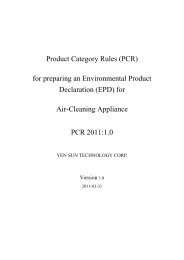Product Category Rules (PCR) - PCR Library
Product Category Rules (PCR) - PCR Library
Product Category Rules (PCR) - PCR Library
You also want an ePaper? Increase the reach of your titles
YUMPU automatically turns print PDFs into web optimized ePapers that Google loves.
11-3 Primary data collection<br />
items<br />
11-4 Primary data Collection<br />
method and<br />
Requirements<br />
packaging to treatment facility.<br />
- GHG emissions associated with incineration at waste treatment facility (other<br />
than CO2 emissions derived from used plastic container and packaging).<br />
- GHG emissions derived from used plastic container and packaging that are<br />
incinerated.<br />
- GHG emissions associated with landfill disposal at treatment facility.<br />
- GHG emissions associated with the processes from “transport for recycling”<br />
up to and including recycling preparation.<br />
- Primary data shall be collected on the items provided in No.11-2.<br />
- For the weight of used plastic container and packaging, the data in the product<br />
specification may be used.<br />
11-5 Scenario [Transport scenario]<br />
GHG emissions associated with transport to facility for disposal/recycling may be<br />
calculated according to the following scenario:<br />
- Transport means: 2-ton truck, transport distance: 50km each way, and loading<br />
ratio: 25%<br />
[Disposal/recycling scenario]<br />
When collection of primary data is difficult, the following scenarios may be used.<br />
(1) Common scenario for plastic container and packaging<br />
a) Use the following disposal ratios of disposal/recycling for calculation.<br />
- Incineration: 62%<br />
- Landfill: 16%<br />
- Recycling: 22%<br />
Since plastic container and packaging for consumer use in the disposal and<br />
recycling stage are disposed as non-industrial waste by municipalities, use<br />
the following ratios for calculation, to avoid underestimation.<br />
- Incineration: 92%<br />
- Landfill: 3%<br />
- Recycling: 5%<br />
b) GHG emissions derived from resin during incineration shall be calculated<br />
based on carbon content thereof. As for the examples of calculation, refer to<br />
“H.1.2, Waste-derived GHG emissions generated from incineration” in<br />
Annex H.<br />
(2) Scenario depending of the type of containers and packaging<br />
When primary data collection is possible, and in the case of designated PET<br />
bottles and the foamed polystyrene containers which have well-established<br />
recycling system, the following scenarios shall be applied.<br />
a) Ratio of each type of waste treatment in the disposal/recycling stage shall<br />
be as follows:<br />
1) Designated PET bottles<br />
- Incineration: 17%<br />
- Landfill: 5%<br />
- Recycling: 78%<br />
2) Foamed polystyrene containers<br />
- Incineration: 39%<br />
- Land-fill: 8%<br />
- Recycling: 53%<br />
b) GHG emissions derived from resin during incineration shall be calculated<br />
based on carbon content thereof. As for the examples of calculation, refer<br />
to “H.1.2, Waste-derived GHG emissions generated from incineration” in<br />
Annex H (normative).<br />
c) As for plastic caps and labels attached to designated PET bottles,“ (1)<br />
Common scenario for plastic containers and packaging” shall be applied.<br />
11-6 Other [Calculating indirect effect]<br />
When primary data collection is possible, and in the case of designated PET<br />
-12-















